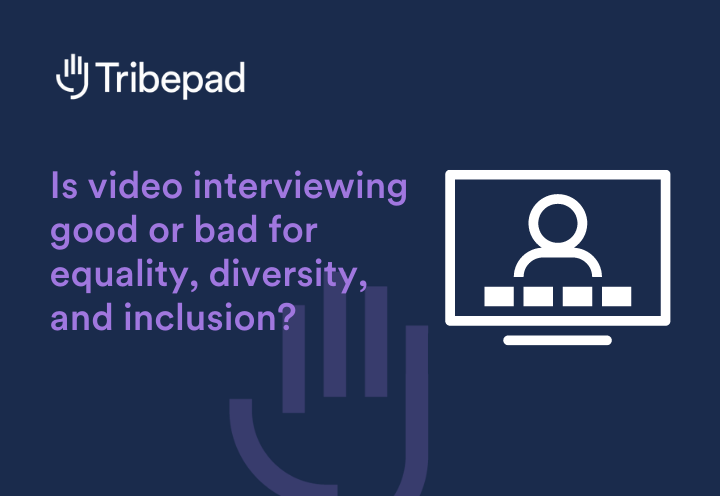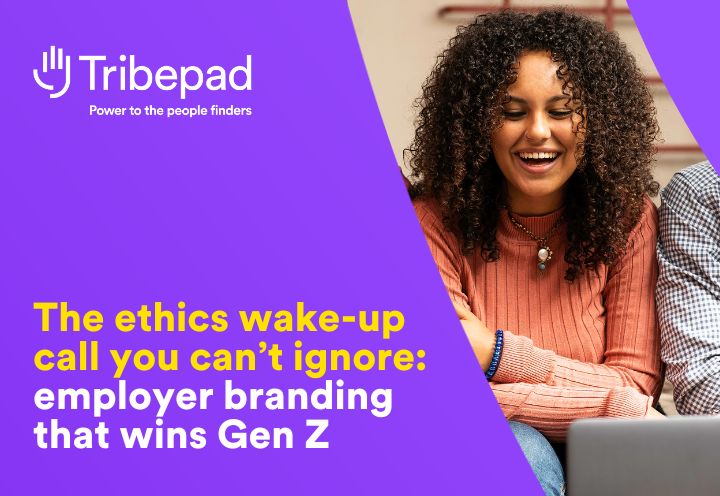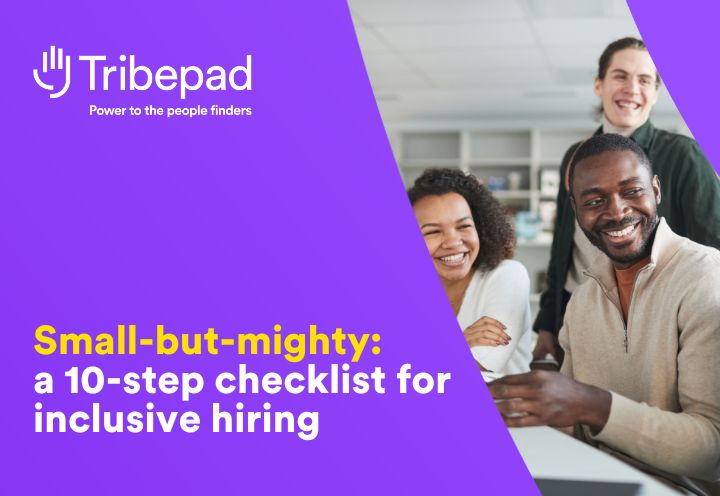From recruiters’ perspective, video interviewing has heaps of benefits. Not least that it turbocharges the interview process, slashing interviewing time by around 90% and scheduling admin by 95%.
But what about from an ED&I perspective? Is video interviewing good or bad for recruiters’ efforts to build a fairer, more inclusive recruitment process?
We recently spoke at the IHR Diversity and Inclusion Virtual Conference (alongside the fabulous Laura Roche, SCS JV’s ED&I Advisor) and asked respondents what they thought.
Read more: 12 practical ways SCS JV are driving ED&I progress
The highest proportion, 44%, said they thought video interviewing was good for ED&I – but nearly the same, 42%, admitted they just weren’t sure.
Let’s unpick the issue. First, the pros.
(A note before we start: what do we actually mean by video interviewing? We’re talking about one-way pre-recorded video interviews here, and we’re seeing many recruitment teams embrace this modern way of interviewing, but see what you think by the end of this article!)
Pros of video interviewing for ED&I
1 – Ensure consistency
Inconsistency is unfair by definition. Even if your team’s already working hard improving consistency – say, with question scripts and robust interview training for telephone interviews – inconsistency can easily sneak in.
Pre-recorded one-way video interviews ensure you’re asking exactly the same questions in exactly the same way, so every candidate gets fair, equal treatment. That’s extremely difficult to achieve with phone or in-person interviews.
2 – Create space for conscious evaluation
Your team probably works hard to identify and remove bias. But unconscious bias is insidious precisely because it’s unconscious. You don’t know what you don’t know, as the saying goes.
In an in-person interview, you’re relying on interviewers to not make the spot judgements and assumptions they probably don’t even realise they make.
Unconscious bias training helps but in a focussed interview environment, interviewers are thinking about a million things. And unconscious habits are extremely difficult to break. (If you’ve ever tried to improve your posture, or stop biting your nails, or whatever, you’ll know exactly what we mean…)
One-way recorded video interviews allow recruiters to evaluate at their own pace, without the distractions and intensity of a live interview situation. It creates space for conscious thought – to rewind; to pause; to review feedback criteria. Live video interviews that automatically record and store recordings do the same.
3 – Expand accountability
Recorded interviews mean you can bring other recruiters into the evaluation process. More eyes-on means splitting the responsibility for evaluation, so individual biases often become less decisive.
It also empowers you to bring people into the evaluation process who might not have been available live. For example, you might have a disabled Black female recruiter based in the US and want her input into a disabled Black female candidate you’re interviewing in EMEA. (Especially since tackling disability bias is still one of the workplace’s biggest issues.)
4 – Reduce hiring manager bias
Depending which video interviewing software you use, it’s possible to anonymise video interviews using AI to transcribe speech to text, and provide analysis. So your hiring managers review based on skills, experience and talent – unconscious biases are given no chance to surface.
5 – Increase accessibility
Both in-person and telephone interviews can be inaccessible on lots of grounds. You expect candidates to take time out of work, for example, which mightn’t be possible for everyone. If interviewing in-person, you expect candidates to navigate the route to your office and your office itself, where there might be accessibility issues.
More important, given the conversations happening right now about the future of flexible and remote work, in-person interviews expect candidates to be physically in your area. Maybe that’s not necessary – and it’s an arbitrary exclusion that also shrinks your talent pool and weakens quality-of-hire.
One-way video interviews allow candidates to interview where and when suits them.
Using dedicated software also means you can leverage the power of technology to improve accessibility options. For instance, with bigger buttons, special help menus, additional audio functionality and screen-reader compatible content.
Advanced video interviewing technology also offers AI translation and transcription, so candidates can interview in the language they’re most comfortable with. So everyone has equal opportunity to make a great impression, wherever they’re from.
6 – Give more people a chance to impress
There are only so many hours in the day. You don’t have an hour to chat to every candidate on the phone (and probably another hour wasted on booking admin…). Especially if you handle high application volumes. Instead, you’re forced to make fast decisions about who’s worth chatting to and who’s not.
That’s a natural consequence of a time-pressured recruitment process – but it does introduce possible unfairness. Maybe someone would’ve been an amazing fit but their written communication skills aren’t great so their CV didn’t make the cut.
In our experience, video interviewing accelerates the interview process by 90% and cuts scheduling admin by 95%. So instead of defaulting towards ruling people out, you can invite more candidates to a first-stage recorded interview for the same time investment – so more people have the opportunity to impress.
7 – Improve visibility to identify and solve issues
Anywhere your recruitment process happens offline creates a data black hole and black holes are the enemy of conscious ED&I progress. Dedicated video interviewing software makes capturing and reporting on comprehensive interviewing data simple, so you can see exactly what’s happening, flag possible issues, and resolve.
Say your engineering team is consistently missing diversity targets. You want to know why so you can help.
Without video interviewing software, you’re reliant on assumptions and best-guesses. Maybe the Head of Engineering says he’s trying his best but can’t find any good female engineers – so, now what? Maybe you invest time into resourcing, to improve diversity in your pipeline. But what if that doesn’t solve the problem?
With video interviewing software, you can analyse bottlenecks to understand why you aren’t successfully hiring female engineers. Maybe it’s not a pipeline problem; maybe there’s unconscious bias happening and the Head of Engineering is consistently ruling women out. Or maybe he’s never seeing the great women who apply, because a recruiter for that team isn’t sending female CVs through. Or maybe he’s taking so long to give interview feedback, in-demand female candidates are dropping out before you can make them an offer.
Video interviewing software gives you the data to take action on ED&I throughout your interview process.
That’s a pretty compelling argument for video interviewing and ED&I. But in the interests of fairness, let’s look at the other side (and how to mitigate these issues, if you do choose video interviewing software).
Cons of video interviewing for ED&I
1 – You’re exposed to protected characteristics earlier
If you use video interviewing to replace telephone interviewing, you’re getting more information about candidates earlier in the process. That’s usually a good thing – but you’re also being exposed to protected characteristics earlier too, which means more potential points for bias.
MITIGATE IT: Choose dedicated software with good reporting (i.e. not just Zoom!) so you can consistently monitor for recurring bias. Consider software that can anonymise interviews (as well as the now-common anonymous applications functionality) ideally on a by-manager basis so you can selectively apply where you suspect you might face issues.
2 – Video interviewing requires some technical awareness and ability
Video interviewing demands a level of tech awareness and ability that telephone and in-person interviewing doesn’t. Candidates who aren’t tech savvy or have technical accessibility issues might face unique challenges that unfairly impact their ability to make a great impression.
MITIGATE IT: Use a simple, intuitive platform with accessible functionality and built-in support to guide candidates through the process. Create educational resources to ensure candidates know exactly what to expect. Reassure candidates who encounter technical issues that it’s not counting against them; provide alternatives if video interviewing is proving untenable.
3 – AI analysis and screening can reflect your own biases
If you’re using dedicated video interview technology, you’re probably also using auto-screening, shortlisting, and rejection functionality. Such features can be problematic. For example, our recent Hybrid Hiring report showed 60% of candidates feel they’d have a fairer chance if they were dealing with a human.
The thing with technology is, it replicates the biases we build into it. For instance, auto-shortlisting candidates who went to certain universities could be perpetuating bias around the demographics attending those institutions.
MITIGATE IT: Be intentional about setting your screening criteria and where possible, invite diverse input into the conversation. Then revisit regularly to ensure you’re not perpetuating unconscious bias.
4 – Video interviews demand internet access
While video interviewing removes potential inequality around, say, travelling to your office, it introduces its own issues. For example, our research showed a worrying 15% of candidates don’t have the means to apply for jobs from home.
Pew Research back that up, finding 66% of Black households and 61% of Hispanic households have home internet access compared to 79% of White households. The same research finds 25% of Hispanic and 23% of Black adults are dependent on smartphones alone for home internet access compared to 12% of White adults.
MITIGATE IT: Choose software that enables candidates to interview anytime, from any device.
We are, and have been for years, huge proponents of video interviewing. Not only because it saves recruitment teams hours and hours each week and makes hiring manager collaboration much easier but because we consistently see it moving the needle on ED&I, especially as a replacement for telephone interviews.
As ever though, we’d love your take. What do you think of video interviewing from an ED&I perspective? What’s been working most for you, to build a fair and inclusive process?




